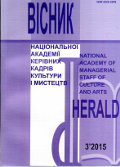FOLK DANCE – AS PART OF THE FESTIVE CALENDAR RITUAL UKRAINIAN CULTURE: A HISTORICAL ASPECT
DOI:
https://doi.org/10.32461/2226-3209.3.2015.138452Keywords:
ritual, syncretic unity, dance, schedrovanie, caroling, nativity scene, magic-ritual dance, household dancesAbstract
Choreographic as poetic and musical heritage, folk dance which is closely linked to the product as a synthetic form of folk art in our people very much. Given this dance as an art work of the people is an integral part calendar festive, ritual culture. When it comes to the culture of a people. We have to consider not only its immediate cultural achievements, but that inheritance he received from his ethnic predecessors, of which he formed and given people. This applies to culture of all nations, including the Ukrainian people. What and noted in this article. The experience gained by humanity during the sociocultural history helps in solving the problems of traditional ritual culture, especially in the current development of our society. Calendar of celebration and ceremony, as an integral part of this culture are closely related to human industrial activity. They are usually accompanied by dancing, singing and playing musical instruments.
The work is clearly apparent view that all the ordinances were closely associated with agriculture animalistic cult. Animalistic personification of natural phenomena in living images of folk games, rites, were limited to the desire to facilitate the work of subordinate natural phenomena and secure welfare.
The article also states that the adoption of Christianity church waged a relentless struggle against pagan customs, ceremonies, traditions declaring them "demonic" and therefore – and with their carriers, creators of folk art. However, before reaching the desired goal, priests parked most folk rituals to your calendar: spring meeting to Easter Christian holidays rusalski holiday – to the Christian Trinity, Midsummer holidays to Iona Baptist carols – to the Christmas and New Year songs – to Jordan holidays. These holidays were accompanied by numerous dances, household and dance scene.
Research began in ancient times these ancient dances were directly related to employment rights. All holidays calendar year cycle of people solemnly celebrated joyfully, with dances, songs, games, entertainment. The presented research draws attention to the fact that raising the dynamic tone, for example, revels and rituals used jumping, jumps, basic prysyadky, turns, etc., which together with the elements of the game, illustrative gestures, facial expressions, complement the stage action.
Historical-Ethnographic Analysis of calendar customs and rituals makes it possible to reconstruct some significant aspects of life, life, outlook and psychology of people since ancient times. Thus the findings complement data historians much written and archaeological sources.
The views expressed in this scientific work some considerations are sometimes hypothetical, severe conduct and require detailed reasoning. But the scope and main objectives of this study do not allow go into the history of the origin of folk dances, their place in the festive rituals and ceremonies. This is a task for the future. And now only attempt was made to inform the general state of the problem, show its complexity, diversity, availability controversial and unresolved issues that require further special study.
Downloads
Published
Issue
Section
License
Authors who publish with this journal agree to the following terms:
1. Authors retain copyright and grant the journal right of first publication with the work simultaneously licensed under a Creative Commons Attribution License International CC-BY that allows others to share the work with an acknowledgement of the work's authorship and initial publication in this journal.
2. Authors are able to enter into separate, additional contractual arrangements for the non-exclusive distribution of the journal's published version of the work (e.g., post it to an institutional repository or publish it in a book), with an acknowledgement of its initial publication in this journal.
3. Authors are permitted and encouraged to post their work online (e.g., in institutional repositories or on their website) prior to and during the submission process, as it can lead to productive exchanges, as well as earlier and greater citation of published work (See The Effect of Open Access).


